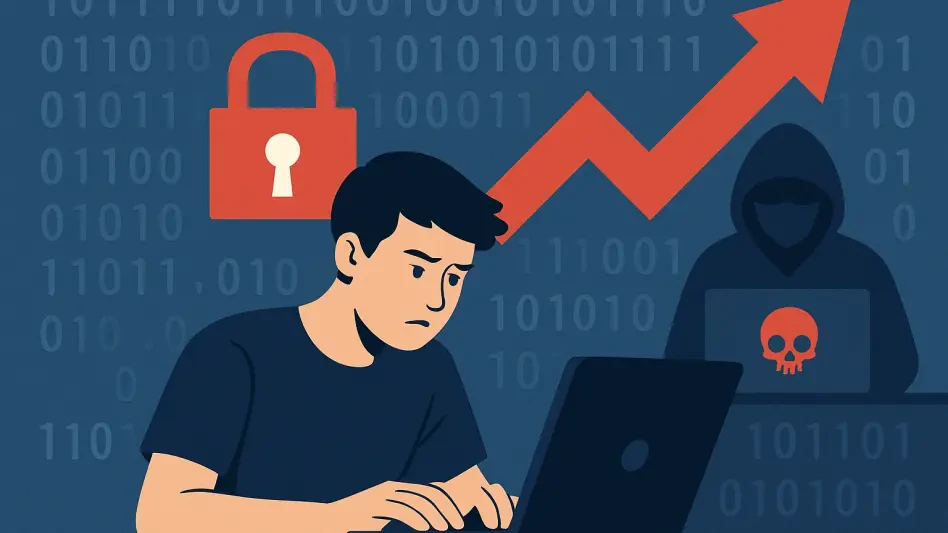In a digital landscape increasingly fraught with danger, the latest data from cybersecurity experts reveals a staggering 21% year-over-year increase in global cyberattacks during the second quarter of this year, painting a grim picture for organizations worldwide. This alarming surge, driven by sophisticated tactics and AI-powered threats, highlights the urgent need for robust defenses as the attack surface continues to expand. No sector appears immune, but one stands out as particularly vulnerable: education. With underfunded security measures and a wealth of exploitable data, educational institutions have become prime targets for malicious actors. As the frequency and complexity of these attacks continue to escalate, this report delves into the key trends, the hardest-hit sectors, and the regions most affected, while also exploring actionable strategies to mitigate the growing risks in an era where cyber threats show no signs of slowing down.
1. Rising Threats Across All Sectors
The numbers are stark: the average organization faced 1,984 weekly cyberattacks in the second quarter, a significant jump from previous periods, with July alone recording an average of 2,011 attacks per week per organization. This steady climb, marked by a 3% increase from the prior month and a 10% rise compared to the same time last year, underscores the relentless adaptability of threat actors. Sophisticated tools, including AI-driven malware, have empowered cybercriminals to exploit vulnerabilities with unprecedented precision. Beyond the raw figures, the diversity of attack methods—ranging from phishing to complex ransomware schemes—has made it challenging for even well-prepared entities to stay ahead. The broadening digital footprint of businesses and institutions, fueled by remote work and cloud adoption, has only widened the opportunities for breaches, leaving cybersecurity teams under immense pressure to respond to evolving threats in real time.
Delving deeper into the impact, certain industries bear a heavier burden than others in this escalating cyber war. The education sector, in particular, has emerged as the most targeted, enduring a staggering 4,388 weekly attacks per organization, up 31% from last year. Government entities follow with 2,632 weekly incidents, a 26% increase, while telecommunications has seen a dramatic 38% surge to 2,612 attacks per week. Education’s vulnerability stems from chronic underfunding of security infrastructure, coupled with vast troves of personal data and credentials ripe for exploitation. Meanwhile, government agencies attract attention due to their sensitive information and geopolitical significance, and telecommunications providers are targeted for their critical role in infrastructure and access to extensive user data. These trends highlight a critical need for sector-specific defenses tailored to address the unique risks and resource constraints faced by each industry.
2. Regional Disparities in Attack Volumes
Geographically, the distribution of cyber threats reveals significant disparities, with some regions experiencing far higher volumes of attacks than others. Africa leads with an average of 3,365 weekly attacks per organization, reflecting a 14% year-over-year increase, followed closely by the Asia-Pacific region at 2,874 attacks, up 15%, and Latin America at 2,803, with a more modest 5% rise. These high volumes often correlate with varying levels of digital infrastructure maturity and regulatory oversight, which can leave certain areas more exposed to exploitation. Cybercriminals frequently target regions where rapid digital transformation outpaces the implementation of robust security measures, exploiting gaps in awareness and technical defenses. As a result, organizations in these areas face a dual challenge of managing high attack frequencies while striving to build resilient systems amidst resource limitations and evolving threats.
Europe, however, stands out for its remarkable growth in cyber incidents, with a 22% year-over-year increase, the highest among all regions. This spike is driven by a combination of geopolitical tensions, fragmented regulatory frameworks, and the region’s concentration of high-value data across industries like finance and technology. The complex interplay of national policies and cross-border data flows often creates inconsistencies in cybersecurity preparedness, making European organizations attractive targets for state-sponsored actors and criminal groups alike. Additionally, the region’s role as a hub for international business amplifies its exposure to sophisticated attacks, including those leveraging ransomware and espionage tactics. Addressing this upward trend requires not only technological investment but also greater collaboration among nations to standardize protections and share threat intelligence, ensuring a unified front against an increasingly borderless threat landscape.
3. Ransomware as a Persistent Menace
Among the myriad forms of cyberattacks, ransomware remains a dominant and destructive force, with around 1,600 global incidents reported in the second quarter through public disclosures on double-extortion “shame sites.” North America accounted for 53% of these cases, while Europe contributed 25%, reflecting the regions’ prominence as economic powerhouses with valuable data to hold hostage. Industries such as business services, industrial manufacturing, and construction & engineering topped the list of victims, representing 10.7%, 9.8%, and 9.5% of reported cases, respectively. The widespread impact across sectors like healthcare, government, and transportation further illustrates ransomware’s indiscriminate reach. These attacks often cripple operations, demand hefty payments, and expose sensitive information, creating a multi-layered threat that challenges even the most fortified defenses in today’s interconnected digital ecosystem.
The mechanics of ransomware have evolved, with double-extortion tactics adding a sinister twist by threatening to leak stolen data if ransoms are not paid. This approach amplifies the pressure on victims, as the potential reputational damage can be as devastating as the operational downtime. Beyond the immediate financial toll, ransomware incidents erode trust in digital systems, prompting organizations to reassess their backup and recovery strategies. The broad range of affected industries signals that no entity is too small or insignificant to be targeted, as cybercriminals increasingly exploit even minor vulnerabilities for profit. Combating this menace demands a multi-faceted response, including advanced threat detection tools, regular system updates, and a cultural shift toward proactive risk management. Only through such comprehensive measures can the pervasive threat of ransomware be mitigated in an environment where attackers continuously refine their methods.
4. Building Stronger Defenses for Tomorrow
Looking back at the alarming rise in cyberattacks during the second quarter, it became evident that organizations had to act decisively to safeguard their digital assets. Investments in threat prevention proved critical, with many adopting advanced technologies like intrusion prevention systems and anti-ransomware tools to block attacks before they inflicted harm. Strengthening endpoint and network defenses through robust firewalls and email security measures helped reduce vulnerabilities, while user awareness programs, including simulated phishing exercises, empowered employees to identify and report suspicious activities. Regular backups and tested recovery plans minimized downtime during incidents, and the adoption of zero trust principles limited unauthorized access. Staying informed through threat intelligence feeds allowed proactive anticipation of emerging risks, marking a pivotal shift toward resilience in the face of relentless cyber threats.
Reflecting on these efforts, the path forward demanded even greater innovation and collaboration to stay ahead of sophisticated adversaries. Organizations needed to prioritize continuous improvement of security protocols, integrating AI-driven analytics to predict and neutralize threats in real time. Governments and industries had to work together to establish global standards for cybersecurity, ensuring consistent protection across borders. Sharing best practices and intelligence could further dismantle the anonymity of threat actors, while increased funding for under-resourced sectors like education offered a chance to close critical gaps. As the digital landscape continued to evolve, embracing a mindset of adaptability and vigilance emerged as the cornerstone of enduring defense, ensuring that the lessons learned from past challenges paved the way for a more secure future against an ever-shifting array of cyber risks.








